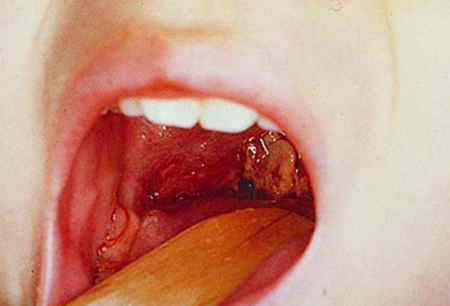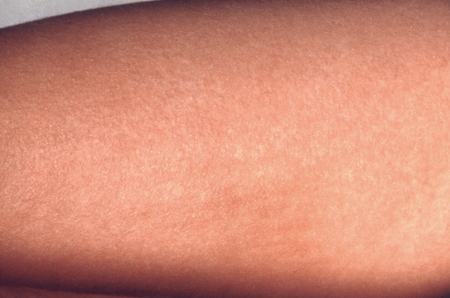Approach
Your Organisational Guidance
ebpracticenet urges you to prioritise the following organisational guidance:
Acute KeelpijnPublished by: Werkgroep Ontwikkeling Richtlijnen Eerste Lijn (Worel)Last published: 2017Mal de gorge aiguPublished by: Groupe de Travail Développement de recommmandations de première ligneLast published: 2017Diagnosis begins with history and physical examination.[4] Patients with clear viral symptoms do not need to undergo testing for Group A Streptococcus (GAS).[4] In the absence of viral symptoms, a rapid antigen detection test and/or throat culture with specific microbiological testing is required to confirm group A Streptococcus (GAS) infection.[4][25][17]
Individuals who are GAS carriers have a positive throat culture or positive rapid antigen test result but do not have clinical symptoms or an immunological response to GAS antigens on laboratory testing. In children, negative rapid antigen tests are confirmed with throat culture.[17][26] Treatment is usually not required for such asymptomatic individuals.[4]
History
Several key elements of the presentation may help determine the causative organism:
Acute GAS pharyngitis is common in children and adolescents aged 5-15 years.[4][26] It is most frequent in the winter (or early spring) in temperate climates.[1] Enteroviral infection is most common in summer and autumn.[1][2] Diagnostic studies for GAS pharyngitis are not indicated for children aged <3 years because acute rheumatic fever is rare and the incidence of streptococcal pharyngitis is uncommon in this age group.[4] However, if they have a sibling with GAS infection then it may be worth considering testing.[1]
Tularaemia is suggested if there is a history of ingestion of undercooked wild animal meat.[9][13][7] History may also include a previous failure of response to a course of penicillin as treatment.[8]
HIV, chlamydia, and gonorrhoea should be considered as causative organisms in sexually active or abused individuals with pharyngitis, especially in those with negative cultures for GAS.[10]
Immunocompromise may follow local tissue damage (e.g., irradiation for oropharyngeal cancer) or have a systemic cause (e.g., chemotherapy, post-transplant immunosuppression, HIV). Candida pharyngitis (e.g., thrush, an oral infection usually by Candida albicans) may be encountered in this clinical context. Culture for the suspected organism is diagnostic.
Lack of immunisation may be a finding in diphtheria or measles.
Symptoms:
Sore throat is a common symptom.[4]
Pain with swallowing.[4]
Fever is common in pharyngitis and is a non-specific symptom.
Headache, nausea, vomiting, and abdominal pain may be present in children.[1][4]
Rhinorrhoea, nasal congestion, hoarseness, oral ulcers, conjunctivitis, and cough may be present in viral pharyngitis but are generally absent in bacterial pharyngitis.[4]
Physical examination
The physical evaluation of acute pharyngitis requires little more than a penlight and tongue depressor.
[Figure caption and citation for the preceding image starts]: Intraoral view of a patient with group A Streptococcus pharyngitisCDC/Heinz F. Eichenwald, MD; public domain [Citation ends].
Other important points to consider:
Absence of cough (with the presence of cervical adenopathy) has the highest specificity for predicting streptococcal aetiology.[27]
Viral infections can be distinguished by the presence of rhinorrhoea, nasal congestion, and cough.[4]
Diphtheria should be considered if a grey membrane is identified in the pharynx or nares. Culture for the suspected organism is diagnostic.[Figure caption and citation for the preceding image starts]: Typical pseudomembrane of diphtheria pharyngitisCopyright Department of Paediatrics and Adolescent Medicine, Princess Margaret Hospital, Hong Kong; used with permission [Citation ends].

Tularaemia is suggested in the presence of ulcerations, exudates, and a history of ingestion of undercooked wild animal meat.[9][13][7] Historical failure of response to penicillin therapy should also raise suspicion. Culture for the suspected organism is diagnostic.
A scarlatiniform rash may be present, especially in children, and is suggestive of GAS.[1][4][Figure caption and citation for the preceding image starts]: Scarlatiniform rash on the forearm due to group A Streptococcus bacteriaCourtesy of the CDC Public Health Image Library [Citation ends].

Koplik spots (bluish-white, raised lesions on an erythematous base on the buccal mucosa) are pathognomonic for measles.[6] A characteristic maculopapular rash or conjunctivitis may also be seen in measles.
In children aged <3 years, GAS rarely manifests as acute pharyngitis. Fever, irritability, and anorexia may be seen, in addition to mucopurulent rhinitis. This presentation in young children is subacute, and high fever is rare.[4]
Laboratory
Rapid antigen detection tests for GAS and traditional throat culture are immensely helpful in the primary care setting and can avoid inappropriate antibiotic use.[28][14] Throat culture is considered the gold standard and may be helpful if the clinical suspicion of GAS is high or disease is caused by other streptococci or other bacterial pathogens such as Achanobacter hemolyticum.[4][25] However, there are some caveats to their use:[29]
GAS rapid antigen detection tests allow immediate point-of-care assessment.
Positive test results in the absence of characteristic symptoms (fever, lack of cough, tonsillar exudates, and tender cervical adenopathy) likely represent colonisation that is not clinically relevant; therefore, testing should be used only when the clinical symptoms are consistent with GAS disease.
GAS rapid antigen detection tests are 70% to 90% sensitive and 95% specific compared with throat culture.[1][30][31] GAS rapid antigen detection tests may have a lower specificity in children recently treated for GAS.[32]
A negative GAS rapid antigen test should be followed by conventional throat culture when there is a high index of suspicion for bacterial pharyngitis, especially in children, given their increased risk of rheumatic fever.[4][33][17][26]
The UK National Institute for Health and Care Excellence recommends against using rapid antigen tests for GAS infections in people aged 5 and over with a sore throat on the grounds of clinical effectiveness in affecting outcomes and microbial stewardship, compared to clinical scoring systems alone.[34]
Nucleic acid amplification (via polymerase chain reaction) testing for GAS is comparable to throat culture in sensitivity and specificity but is more rapid. In addition, PCR use in children with GAS in primary care led to more appropriate antibiotic use.[35] However, rapid in-office PCR is not widely available.[35][36][37][38]
Throat culture is particularly useful when rapid antigen tests are negative for GAS but the clinical syndrome is consistent with GAS. Rapid antigen tests will not detect other streptococci or Arcanobacterium haemolyticum that can be clinically indistinguishable from GAS pharyngitis.
Haemophilus influenzae, Staphylococcus aureus, Neisseria meningitidis, and Streptococcus pneumoniae are not aetiological agents of acute pharyngitis and should not be identified or reported in throat cultures.[17]
The Centers for Disease Control and Prevention recommend that the Monospot test is not used. The antibodies detected by Monospot can be caused by conditions other than infectious mononucleosis and does not confirm the presence of EBV infection.[39]
Test of cure (with a follow-up throat culture or rapid antigen test for GAS) is not routinely required except in patients who are at high risk of acute renal failure or who have recurrence of symptoms compatible with GAS.[1] Test of cure is recommended for patients with gonococcal pharyngitis.
For adults with symptoms of pharyngitis, laboratory testing is not always indicated.[25] Instead, all adult patients with symptoms of pharyngitis should be screened using prediction rules (e.g., Centor criteria, McIsaac, or FeverPAIN).
Centor criteria:[40]
History of fever
Lack of cough
Tonsillar exudates
Tender anterior cervical adenopathy.
Adults with none or only one of these findings should not be tested or treated for GAS. Individuals who meet two or more Centor criteria should have a rapid antigen test.[25]
Treatment failure in a patient without laboratory confirmation of GAS should prompt culture for bacterial agents other than GAS, and examination for evidence of viral disease.
McIsaac scoring system
The McIsaac scoring system modifies the Centor algorithm to account for the increased prevalence of GAS in children.[41]
Tonsillar swelling or exudate (add 1 point)
Tender anterior cervical adenopathy (add 1 point)
No cough (add 1 point)
Temperature > 38°C (add 1 point)
Aged 3-14 years (add 1 point)
Aged 15-44 years (no points)
Aged ≥45 years (minus 1 point).
Like the Centor algorithm, a higher McIsaac composite score means greater risk of a GAS infection.
FeverPAIN:[42]
Fever (during previous 24 hours)
Purulence (pus on tonsils)
Attend rapidly (within 3 days after onset of symptoms)
Severely inflamed tonsils
No cough or coryza (inflammation of mucous membranes in the nose).
Each of the FeverPAIN criteria score 1 point (maximum score of 5). Higher scores suggest more severe symptoms and likely bacterial (streptococcal) cause. A score of 0 or 1 is thought to be associated with a 13% to 18% likelihood of isolating Streptococcus. A score of 2 or 3 is thought to be associated with a 34% to 40% likelihood of isolating Streptococcus. A score of 4 or 5 is thought to be associated with a 62% to 65% likelihood of isolating Streptococcus.
In the UK, the Centor and FeverPAIN scores are the two prediction rules recommended by the National Institute for Health and Care Excellence (NICE).[43] Although these scoring systems are not definitive they can be used to increase pretest probability and limit detection of GAS carriage in pharyngitis due to other aetiologies.[44]
With the advent of a number of point-of-care in vitro diagnostic tests for GAS detection, the NHS England Diagnostics Board and the UK Health Security Agency have laid down best practice principles for clinicians in the UK with the aim to ensure that a cautious approach is used while interpreting the results of such tests and only testing individuals with a high index of suspicion for GAS disease (i.e. those with elevated Centor or FeverPAIN scores).[45] The British Infection Association and the Royal College of General Practitioners endorse this initiative.
Radiology
Acute pharyngitis does not usually require radiographical diagnosis. If clinical symptoms are concerning for retropharyngeal abscess (toxic appearance, neck stiffness/swelling, or vocal changes), then a computed tomography scan of the neck with intravenous contrast should be obtained.
Use of this content is subject to our disclaimer